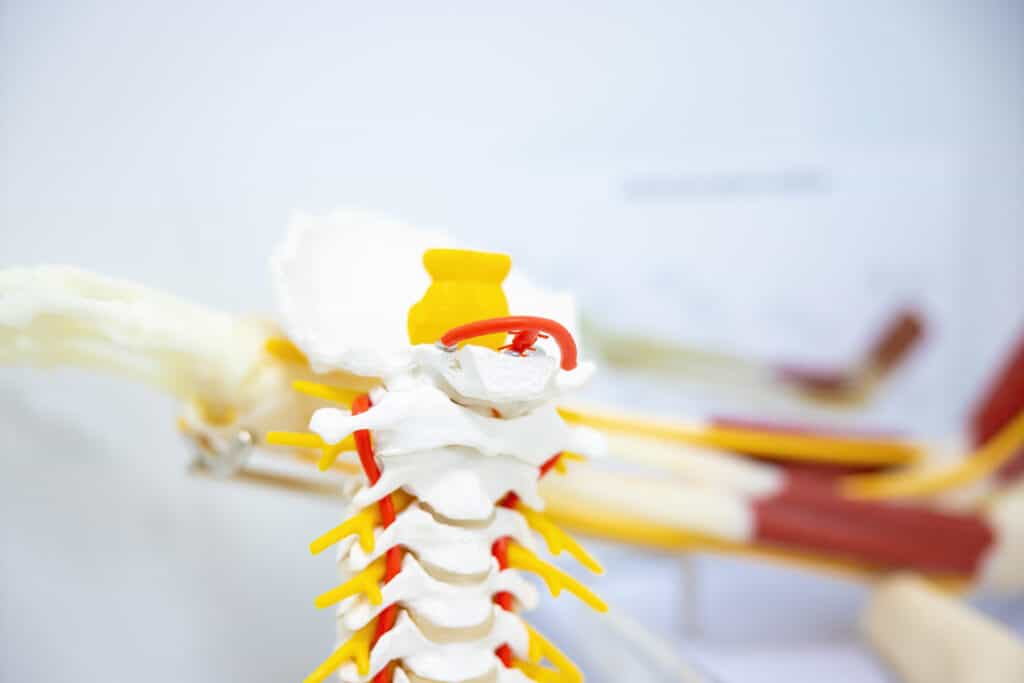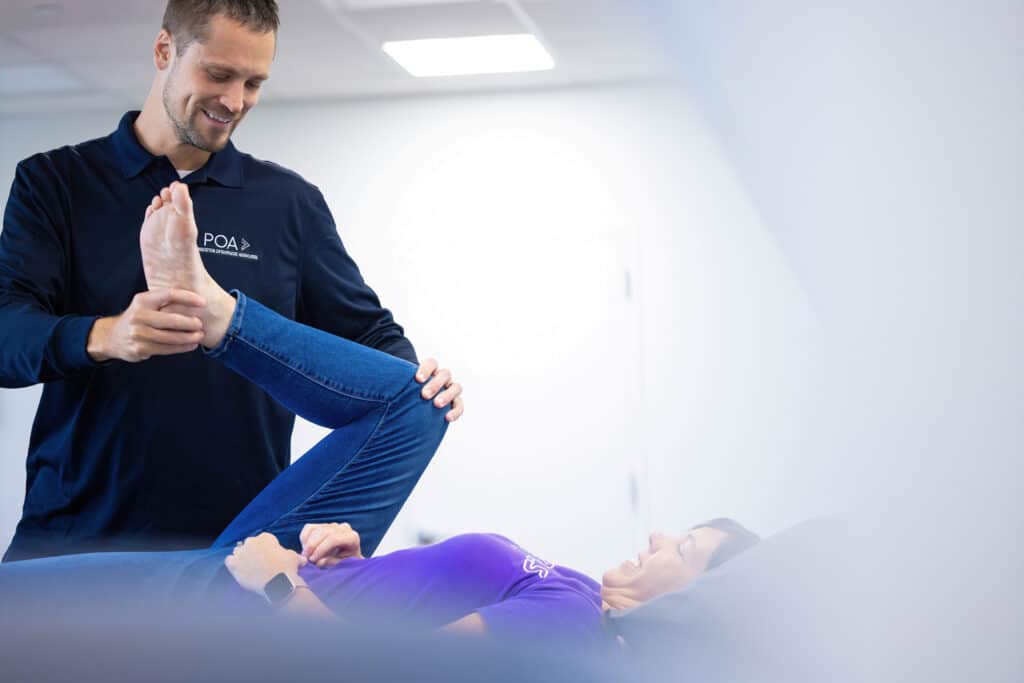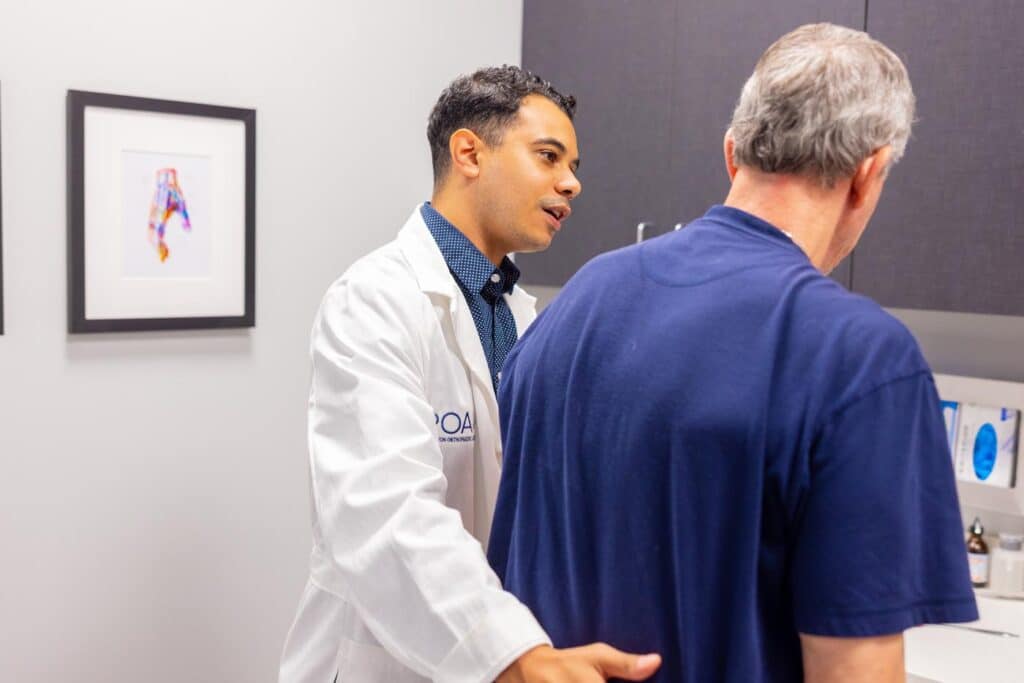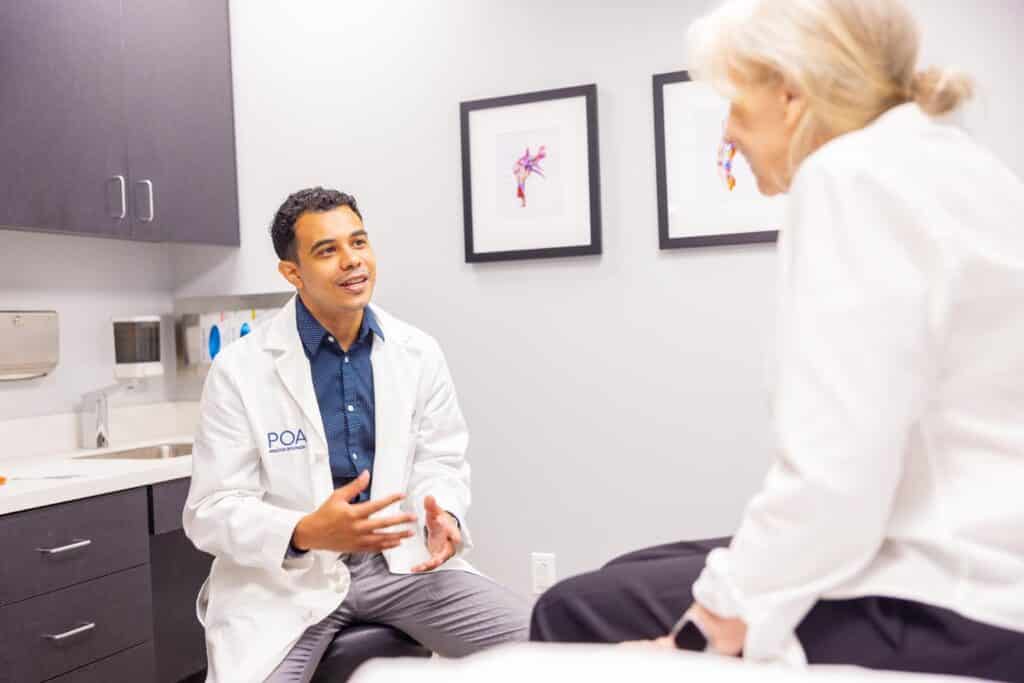
Physician Assistants
Physical & Occupational Therapists
KneeMRI ScansNon-OperativePhysiatry
Physical Therapy
Podiatry
Spine
Sports Medicine
TraumaUrgent Care
X-Ray Imaging

When you suffer from sciatica, it can feel like your world has come to an end. You might not know what is happening to you and how long you will have to live with these painful symptoms. Treating this condition can be difficult because most exercises and stretches that you find online aren’t specific for sciatica. This means the general advice about stretching won’t help much in this case. This article will help you understand the causes of sciatica, as well as different treatments for it. So keep reading for more information about the best stretches for sciatica pain and how to get rid of it fast.
Sciatica is a condition in which the sciatic nerve, the largest of the spinal nerves, is irritated by either a herniated disk in the back or some other structural problem in the spine. The pain usually starts from your lower back and radiates to your buttocks and down one leg. In most cases, sciatica can be treated with exercises, stretching, and medication. The goal when treating this condition is to reduce inflammation and muscle spasm around the sciatic nerve so that it will heal properly.

Sciatica is a nerve disorder that causes pain in the lower back and down the legs. The sciatic nerve is the longest nerve in your body, so when it becomes pinched or inflamed, it can cause intense pain. Most people who experience sciatica feel pain in the back of their thigh or buttock, as well as shooting pain into one of their legs. Fortunately, there are ways to get rid of this pain for good. The best stretches for sciatica relief are stretches that target the piriformis muscle. Piriformis syndrome occurs when the piriformis muscle goes too long without being stretched. This muscle helps stabilize and rotate your hip joint and causes inflammation when it becomes tight or overworked. To stretch this muscle, sit on the floor with both feet flat on the ground about shoulder-width apart. Stretch your arms out in front of you so they’re at a right angle with your torso and place one hand on either side of your hips. Press into your hands to move yourself forward and backward until you find a comfortable stretch in your hips and buttocks and hold for 30 seconds before releasing slowly. These simple stretches can help relieve sciatica pain quickly while also strengthening those muscles so they don’t go into spasm again!

There are many stretches that can help relieve sciatica pain. At the same time, there are also some stretching routines that you should avoid. For example, exercises like deep squats or lunges will only worsen your pain. So what are the best stretches for sciatica?

Sciatica is a condition that can affect your lower back, buttocks and legs. It's usually caused by a pinched sciatic nerve in your spine that results in pain and discomfort. Sciatica pain can be debilitating, but there are steps you can take to get relief. The best way to treat sciatica is through stretching, which will help you maintain a healthy spine and lessen the chance of future flare-ups. You can also do exercises that strengthen your core and lower body, which may help to decrease pain. In addition to stretching and exercising, you should consult a doctor who specializes in sciatica treatment for the most effective care. Sciatica is a painful condition that can cause discomfort for people of all ages. The good news is that there are steps you can take to get relief. The best way to treat sciatica is through stretching, which will help you maintain a healthy spine and lessen the chance of future flare-ups. You can also do exercises that strengthen your core and lower body, which may help to decrease pain. In addition to stretching and exercising, you should consult a doctor who specializes in sciatica treatment for the most effective care.
We are proud to be a leading resource for those seeking information about sciatica, a common and often debilitating condition. Understanding how challenging sciatica can be, we've gathered all our valuable resources in one convenient location, making it easier for you to access the information you need. Whether you're looking for treatment options, tips for managing symptoms, or guidance on prevention, our goal is to provide you with reliable and comprehensive support to help you navigate your journey toward relief.
Updated November, 2024
When you suffer from sciatica, it can feel like your world has come to an end. You might not know what is happening to you and how long you will have to live with these painful symptoms. Treating this condition can be difficult because most exercises and stretches that you find online aren’t specific for sciatica. This means the general advice about stretching won’t help much in this case. This article will help you understand the causes of sciatica, as well as different treatments for it. So keep reading for more information about the best stretches for sciatica pain and how to get rid of it fast.
Sciatica is a condition in which the sciatic nerve, the largest of the spinal nerves, is irritated by either a herniated disk in the back or some other structural problem in the spine. The pain usually starts from your lower back and radiates to your buttocks and down one leg. In most cases, sciatica can be treated with exercises, stretching, and medication. The goal when treating this condition is to reduce inflammation and muscle spasm around the sciatic nerve so that it will heal properly.

Sciatica is a nerve disorder that causes pain in the lower back and down the legs. The sciatic nerve is the longest nerve in your body, so when it becomes pinched or inflamed, it can cause intense pain. Most people who experience sciatica feel pain in the back of their thigh or buttock, as well as shooting pain into one of their legs. Fortunately, there are ways to get rid of this pain for good. The best stretches for sciatica relief are stretches that target the piriformis muscle. Piriformis syndrome occurs when the piriformis muscle goes too long without being stretched. This muscle helps stabilize and rotate your hip joint and causes inflammation when it becomes tight or overworked. To stretch this muscle, sit on the floor with both feet flat on the ground about shoulder-width apart. Stretch your arms out in front of you so they’re at a right angle with your torso and place one hand on either side of your hips. Press into your hands to move yourself forward and backward until you find a comfortable stretch in your hips and buttocks and hold for 30 seconds before releasing slowly. These simple stretches can help relieve sciatica pain quickly while also strengthening those muscles so they don’t go into spasm again!

There are many stretches that can help relieve sciatica pain. At the same time, there are also some stretching routines that you should avoid. For example, exercises like deep squats or lunges will only worsen your pain. So what are the best stretches for sciatica?

Sciatica is a condition that can affect your lower back, buttocks and legs. It's usually caused by a pinched sciatic nerve in your spine that results in pain and discomfort. Sciatica pain can be debilitating, but there are steps you can take to get relief. The best way to treat sciatica is through stretching, which will help you maintain a healthy spine and lessen the chance of future flare-ups. You can also do exercises that strengthen your core and lower body, which may help to decrease pain. In addition to stretching and exercising, you should consult a doctor who specializes in sciatica treatment for the most effective care. Sciatica is a painful condition that can cause discomfort for people of all ages. The good news is that there are steps you can take to get relief. The best way to treat sciatica is through stretching, which will help you maintain a healthy spine and lessen the chance of future flare-ups. You can also do exercises that strengthen your core and lower body, which may help to decrease pain. In addition to stretching and exercising, you should consult a doctor who specializes in sciatica treatment for the most effective care.
We are proud to be a leading resource for those seeking information about sciatica, a common and often debilitating condition. Understanding how challenging sciatica can be, we've gathered all our valuable resources in one convenient location, making it easier for you to access the information you need. Whether you're looking for treatment options, tips for managing symptoms, or guidance on prevention, our goal is to provide you with reliable and comprehensive support to help you navigate your journey toward relief.
Updated November, 2024
Are you experiencing the discomfort and pain associated with sciatica? You're not alone. Sciatica is a prevalent condition characterized by radiating pain from the lower back down the leg, often due to compression or irritation of the sciatic nerve. Like you, many people find themselves trying to figure out how to relieve sciatica nerve pain or how to stop sciatica pain. Among the various available treatments, targeted exercises have proven highly effective in managing sciatica. In this blog, we will explore the world of sciatica exercises, providing you with a comprehensive guide to help relieve your pain and restore your mobility.

Before we delve into specific exercises, it's essential to understand why exercise is so beneficial for sciatica:

1. Pelvic Tilt:
2. Knee to Chest Stretch:
3. Cat-Cow Stretch:
4. Child's Pose:
5. Piriformis Stretch:
6. Walking:

Please contact us! We'd love to help.
If you are suffering from sciatica pain, please contact us and schedule an appointment. We have urgent care facilities all over New Jersey for your convenience.
Incorporating a regular routine of sciatica-specific exercises can significantly contribute to managing and alleviating your pain. However, it's crucial to consult with a healthcare professional or physical therapist before initiating any exercise program, especially if you have a severe or chronic condition. They can provide personalized guidance and ensure that your chosen exercises are safe and appropriate for your specific situation. You can contact us to schedule with one of our experts here: Schedule an Appointment.
Remember, consistency is key, and, over time, these exercises can lead to improved mobility, reduced pain, and a better quality of life.
Learn more about sciatica:
We are proud to be a leading resource for those seeking information about sciatica, a common and often debilitating condition. Understanding how challenging sciatica can be, we've gathered all our valuable resources in one convenient location, making it easier for you to access the information you need. Whether you're looking for treatment options, tips for managing symptoms, or guidance on prevention, our goal is to provide you with reliable and comprehensive support to help you navigate your journey toward relief.
Updated November, 2024
Sciatica is a painful condition characterized by radiating pain along the path of the sciatic nerve, often accompanied by symptoms like numbness and weakness in the leg. It can be caused by various factors, including herniated discs, bone spurs, tumors, or underlying diseases like diabetes. Effective management of sciatica typically involves a combination of treatments, ranging from conservative measures like rest and medications to physical therapy and, in severe cases, surgical interventions. Seeking professional care and a tailored treatment plan, such as those provided by Princeton Orthopaedic Associates, is crucial for alleviating pain, improving mobility, and enhancing one's overall quality of life.


Please contact us! We'd love to help.
If you are suffering from sciatic pain, please contact us and schedule an appointment. We have urgent care facilities all over New Jersey for your convenience.
Effective treatment for sciatica can significantly improve your quality of life. If you're experiencing sciatica symptoms, it's essential to seek professional care for a tailored treatment plan. Princeton Orthopaedic Associates is here to assist you on your journey to relief and recovery. You can contact us to schedule with one of our experts here: Schedule an Appointment.
Learn more about sciatica:
Sciatica is characterized by a distinctive set of symptoms that can significantly impact one's daily life. It typically involves radiating pain along the path of the sciatic nerve, stretching from the lower back down through the hips, buttocks, and into the legs. This pain can vary in intensity, ranging from a mild ache to sharp, burning sensations, often compared to electric shocks. Activities like coughing, sneezing, or prolonged sitting can exacerbate the pain, which usually affects only one side of the body. Additionally, individuals with sciatica may experience numbness, tingling, or muscle weakness in the leg or foot, leading to varying sensations in different parts of the leg. Recognizing these symptoms is crucial for timely diagnosis and effective treatment.


Please contact us! We'd love to help.
If you have pain, please contact us and schedule an appointment. We have urgent care facilities all over New Jersey for your convenience.
Recognizing the symptoms of sciatica is essential for seeking timely medical attention. In our next blog, we'll explore the underlying causes of sciatica, shedding light on why this condition occurs. If you think you are suffering from Sciatica, it's crucial to consult with a healthcare professional, especially if you have a severe or chronic condition. They can provide personalized guidance and ensure your chosen exercises are safe and appropriate for your situation. You can contact us to schedule with one of our experts here: Schedule an Appointment.
More on sciatica:
Sciatica is a condition that can cause excruciating pain and discomfort. In this blog, we'll provide an overview of what sciatica is, helping you understand the basics of this common nerve-related ailment.
Sciatica is a term used to describe a set of symptoms rather than a specific medical condition. It refers to pain that radiates along the path of the sciatic nerve. This pain can vary from mild to severe and is often accompanied by other symptoms like numbness and tingling. It occurs when the sciatic nerve, which is the longest nerve in the human body, becomes irritated or compressed. The sciatic nerve runs from the lower back, through the buttocks, and down the back of each leg. Sciatica typically affects only one side of the body.
Understanding the fundamentals of sciatica is the first step in managing this condition. Look at our other blogs, where we'll delve deeper into sciatica causes, symptoms, and exercises, helping you identify if you might be experiencing this nerve-related pain.

You can read more about sciatica here:

Please contact us! We'd love to help.
If you are suffering from sciatica, please contact us and schedule an appointment. We have urgent care facilities all over New Jersey for your convenience.
If you think you are suffering from Sciatica, it's crucial to consult with a healthcare professional, especially if you have a severe or chronic condition. They can provide personalized guidance and ensure your chosen exercises are safe and appropriate for your situation. You can contact us to schedule with one of our experts here: Schedule an Appointment.

Pickleball has skyrocketed in popularity, quickly becoming among the most exciting and engaging sports across the United States and beyond. It's a game for people of all ages, combining elements of tennis, badminton, and ping-pong. As the sport's popularity increases, so does the number of associated injuries. Among the most common and concerning pickleball injuries is the Achilles tendon rupture.
With the increase in popularity, pickleball injuries are becoming more and more common, especially Achilles ruptures. Keep reading to learn everything you need to know about Achilles ruptures, why they're common in pickleball, treatment options, and, most importantly, how to prevent them.
The Achilles tendon is the thick band of tissue connecting your calf muscles to your heel bone. It is one of the strongest tendons in the body, allowing you to perform activities like walking, running, and jumping by facilitating foot and ankle movement. However, because the Achilles tendon is so crucial to the lower-body movement, it's also vulnerable to injury, especially during activities involving sudden starts, stops, and changes in direction—like pickleball.
Pickleball is fun and engaging, but it requires rapid foot movements, sudden pivots, and quick bursts of acceleration, which can place significant stress on the Achilles tendon. Players are often required to move laterally across the court or quickly dash forward to reach the ball. These explosive movements can overwhelm the Achilles, especially if you aren't properly conditioned for this activity level or haven't warmed up adequately before playing.
Pickleball is particularly popular among older adults, who may not have the strength and flexibility they once did. Our tendons naturally become less flexible as we age, increasing the risk of injury during high-impact sports. In pickleball, Achilles ruptures are particularly common due to this combination of sudden movements and the demographic of players.
An Achilles rupture often occurs suddenly and is typically accompanied by a distinct popping or snapping sound, followed by intense pain in the back of your lower leg.

Some common symptoms of an Achilles rupture include:
If you experience any of these symptoms, especially after a sudden movement or pivot, it's essential to seek medical attention immediately. Prompt treatment is crucial for your successful recovery.
11 Centre Drive
Monroe Twp., NJ 08831
5 Plainsboro Road, Suite 100
Plainsboro, NJ 08536
1 Union Street Suite 305
Robbinsville, NJ 08691
325 Princeton Avenue
Princeton, NJ 08540
315 US Highway 206
Hillsborough Township, NJ 08844
200 Charles Ewing Blvd. Suite 170
Ewing, NJ 08628
There are two primary approaches to treating an Achilles tendon rupture: non-surgical and surgical treatments. The best option for each patient depends on factors like the severity of the rupture, the patient's age, activity level, and overall health.
Non-surgical treatment is typically recommended for less active individuals or those with a minor Achilles tear. This approach involves immobilizing the foot with a cast or boot, which allows the tendon to heal on its own. Over time, the tendon will reattach, and physical therapy can help restore strength and flexibility. While non-surgical treatment can be effective, the recovery process is longer, and the re-injury risk may be higher than surgical repair.
For most active individuals, surgical repair is the preferred treatment option. Surgery involves reconnecting the torn ends of the Achilles tendon. In the past, this procedure required a large incision and a long period of immobilization, often leading to muscle atrophy, stiffness, and swelling. Patients would be placed in a long leg cast for months, followed by a lengthy rehabilitation period.
Fortunately, advances in orthopedic surgery now allow for minimally invasive procedures. Surgeons can repair the Achilles tendon through small incisions, reducing the risk of complications and allowing for quicker recovery times. With this technique, patients can begin physical therapy sooner, regain mobility faster, and reduce the risk of long-term stiffness or weakness.
The good news is that most people can return to the sports and activities they love with proper treatment. Whether you opt for non-surgical or surgical treatment, a comprehensive rehabilitation program is essential for regaining strength and mobility.
When you see one of our orthopaedic specialists here at POA, they will create a personalized treatment plan for your specific situation. Following your surgeon's recommendations, which may include closely working with a physical therapist, helps to ensure a full recovery. With the right care, many pickleball players can return to the court within 6 to 12 months.
While Achilles ruptures can be a serious and painful injury, there are steps you can take to reduce your risk of experiencing one.
Make sure you warm up before playing pickleball. A proper warm-up is essential to reduce your risk of injury. Before playing pickleball, spend 5 to 10 minutes stretching your calf muscles and Achilles tendons. Include dynamic stretches such as calf raises, ankle circles, and gentle jogging to get your muscles warm and ready for action.
Strengthen Your Calf Muscles. Building strength in your calf muscles can help take the load off your Achilles tendon. Incorporate exercises such as heel raises, resistance band exercises, and leg presses into your routine to strengthen the muscles that support the Achilles.
Gradually increase your game activity. If you're new to pickleball or haven't played in a while, ease into the game. Avoid going all out in your first few sessions. Gradually increase the intensity and duration of your games to allow your body to adapt.
Wear Proper Footwear. Supportive shoes are key in protecting your Achilles tendon. Make sure your shoes have good arch support and cushioning to absorb the impact of quick stops and starts on the pickleball court.
Listen to Your Body. If you experience any pain or tightness in your Achilles, it's important that you take a break and rest. Overworking the tendon can increase your risk of injury. Make sure you pay attention to how your body feels, and don't push through discomfort!
Pickleball is an exciting and fast-growing sport! It's important to pay attention to the injury risks associated with it, particularly Achilles ruptures. While the injury can be serious, advances in treatment—such as minimally invasive surgery—allow for faster recovery and a return to the activities you love. By taking preventative measures like warming up, strengthening your muscles, and wearing proper footwear, you can reduce your risk of injury and continue enjoying the game.
If you do experience an Achilles injury, seek medical attention immediately. The sooner you receive treatment, the better your chances of a full recovery. With the right care and rehabilitation, many players can return to the pickleball court stronger than ever.

Please contact us! We'd love to help.
If you have pain, please contact us and schedule an appointment. We have urgent care facilities all over New Jersey for your convenience.
This blog post is meant to be informative and should not act as a self-diagnosis tool. If you’d like to see one of our doctors, please contact us here.
Are you experiencing the discomfort and pain associated with sciatica? You're not alone. Sciatica is a prevalent condition characterized by radiating pain from the lower back down the leg, often due to compression or irritation of the sciatic nerve. Like you, many people find themselves trying to figure out how to relieve sciatica nerve pain or how to stop sciatica pain. Among the various available treatments, targeted exercises have proven highly effective in managing sciatica. In this blog, we will explore the world of sciatica exercises, providing you with a comprehensive guide to help relieve your pain and restore your mobility.

Before we delve into specific exercises, it's essential to understand why exercise is so beneficial for sciatica:

1. Pelvic Tilt:
2. Knee to Chest Stretch:
3. Cat-Cow Stretch:
4. Child's Pose:
5. Piriformis Stretch:
6. Walking:

Please contact us! We'd love to help.
If you are suffering from sciatica pain, please contact us and schedule an appointment. We have urgent care facilities all over New Jersey for your convenience.
Incorporating a regular routine of sciatica-specific exercises can significantly contribute to managing and alleviating your pain. However, it's crucial to consult with a healthcare professional or physical therapist before initiating any exercise program, especially if you have a severe or chronic condition. They can provide personalized guidance and ensure that your chosen exercises are safe and appropriate for your specific situation. You can contact us to schedule with one of our experts here: Schedule an Appointment.
Remember, consistency is key, and, over time, these exercises can lead to improved mobility, reduced pain, and a better quality of life.
Learn more about sciatica:
Sciatica is a painful condition characterized by a range of symptoms, primarily radiating pain along the path of the sciatic nerve. Understanding the underlying causes of sciatica is essential in its effective management. Common causes include herniated discs, bone spurs, tumors, or diseases like diabetes. Identifying the root cause of your sciatica is a vital step toward tailored treatment plans that can alleviate pain and improve your quality of life. If you suspect you may have sciatica, seeking professional care, such as that provided by Princeton Orthopaedic Associates, can help diagnose the cause and initiate appropriate treatment for lasting relief. Understanding the causes of sciatica is vital to effectively managing this condition. In this blog, we'll delve into the primary factors that lead to the development of sciatica.

Understanding the root causes of sciatica is essential for tailoring appropriate treatment plans. In our upcoming blog, we'll explore the various treatment options available for managing sciatica and alleviating its symptoms.

Please contact us! We'd love to help.
If you are suffering from sciatic nerve pain, please contact us and schedule an appointment. We have urgent care facilities all over New Jersey for your convenience.
If you think you are suffering from Sciatica, it's crucial to consult with a healthcare professional, especially if you have a severe or chronic condition. They can provide personalized guidance and ensure your chosen exercises are safe and appropriate for your situation. You can contact us to schedule with one of our experts here: Schedule an Appointment.
More on Sciatica:

Sciatica Resources
If you're experiencing sciatic nerve pain, you're not alone. Sciatica is a common condition that affects millions of people, often causing debilitating pain and making even the simplest daily activities feel challenging. If you've ever had sciatica, you are well versed in this intense pain that radiates along the sciatic nerve, which runs from your lower back, through the hips, and down each leg. When the nerve is compressed, it can lead to symptoms ranging from mild discomfort to intense, burning pain, along with tingling, numbness, and weakness. Sciatica's prevalence and the severity of its symptoms make it one of the most commonly treated conditions in orthopedic practices, and it can affect people of all ages, though it's particularly common in middle-aged and older adults.
Living with sciatica can be overwhelming, as it often impacts your ability to work, exercise, and enjoy leisure activities. At POA, we understand how important it is to manage and treat sciatica effectively to minimize its impact on your life. Whether you're experiencing your first bout of sciatica or have dealt with chronic flare-ups, our team of orthopedic specialists is here to provide guidance, information, and effective treatment options.

Please contact us! We'd love to help.
If you have pain, please contact us and schedule an appointment. We have urgent care facilities all over New Jersey for your convenience.
To make navigating resources easier, we've compiled a list of previous POA blogs on sciatica and related topics. From what causes sciatica to sciatica stretches, this resource list will help you navigate information on sciatica's causes, symptoms, treatment options, and prevention strategies, all in one place. Explore these blogs to understand your condition better and discover tips and techniques to find relief and regain control over your life.
